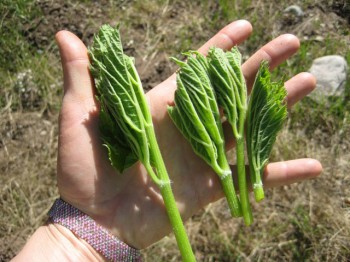
The other day I wrote about fireweed, the wild edible plant that Gregory Tilford chose to honor by adorning the front cover of his book with it.
Earning a similar distinction on the cover of Kathryn G. and Andrew L. March’s 1979 guide, Common Edible and Medicinal Plants of Colorado with Recipes and Prescriptions, is cow parsnip, a plant that shares its classification in the Umbelliferae family with regular parsnip, carrots, parsley, dill, coriander, fennel, and anise.
“The fresh young shoots and the first leaves, just as they are unfolding, are a most exotic, wild and woolly, stimulating taste, a bold stroke to mark off the mid-spring and early summer season,” the Marchs write. “The flavor is one of a kind, with at most distant echoes of fresh coriander, strange at first but one comes to crave it.”
After reading that, I had to have some.
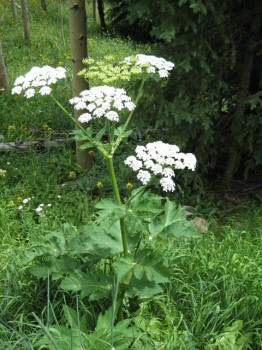
There was only one catch. The Umbilliferae family comes with strong warnings from the wild foods literature on account of some extremely toxic family members, including poison hemlock (Conium maculatum) and water hemlocks (Cicuta genus) which also sport the large white umbrella-shaped umbels of tiny flowers for which the family is named. Unlike its poisonous cousins, cow parsnip (Heracleum maximum) has big, maple-leaf-shaped leaves. Similar to them, however, the mature plant features a tall stalk with big flower heads that look something like Queen Anne’s Lace.
The poison-risk-factor is why finding the new shoots and leaves of cow parsnip ended up becoming a two year process for Gregg and me. Last summer we identified the mature plants, making absolutely certain of our identification with the aid of numerous guide books. We remembered where the plants were located and returned this year to find the young shoots and leaves, often alongside the tall, dry stalks of last year’s flowers.
We tasted our first cow parsnip a few days ago following a recipe in the Marchs’ book that calls for boiling the plant parts for 10 minutes, changing the water, boiling for another ten minutes, and then adding soy sauce, butter, and chopped onions.
It was a unique taste, to say the least. I don’t know what fresh coriander tastes like, but cow parsnip tastes like nothing I’ve ever tasted before. Gregg opined that the raw onions were key to the recipe. I swear I’ve never seen this in the two years that we’ve known each other, but Gregg—the supposed onion-hater–got up and helped himself to a second serving of raw onions.
All in all, the cow parsnip was good. Weird, but good.
Finding the Cow Parsnip
Today, after meeting with my bank-provided financial advisor on how on earth I am going to make a proper living as a freelance writer/snowboard bum, I stopped by a less-than-wild roadside spot where we had seen mature cow parsnip the year before.
Sure enough, I spotted the big maple-shaped leaves out the passenger window, so I pulled into a convenient nook and parked the car. There was not a soul in sight and I headed down the steep embankment to snip a couple of small, fuzzy leaves and stems, filling a small bag after 15 minutes. I have to admit that the spot might have been a bit too close to the road for comfort (roads = pollution on your plants) if it weren’t for the fact that it seemed so little trodden. Afterwards I climbed back up, took my wild booty to the car, and drove up the street for round two of the adventure.
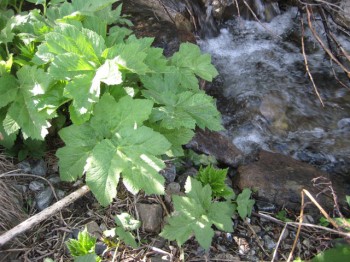
My plan was to explore a swollen spring stream in a section of national forest, since a recent call to the ranger station revealed that I can sustainably forage small amounts of plants for personal use in the Pike and San Isabel National Forests. I parked the car, grabbed my scissors and bags, and followed the stream up on its darker, forested side, thinking all the while that the tangled mass of willows and undergrowth on the other side might be a better spot for cow parsnip. When the opportunity presented itself, I crossed and waded into the underbrush on the other side. Sure enough, it was a veritable jackpot of cow parsnip!
According to knowledge gleaned from the Marchs’ book, the foraging of cow parsnip involves taking small, fuzzy, leaves—both those which are not quite unfurling and those which are just starting to unfurl, succulent stems and all. I stuck to the Marchs’ suggestion to harvest “plants no higher than 6 inches,” staying on the willowy side of the stream while following it back roughly in the direction from which I’d come.
You have to keep an eye out for it, but once you start to recognize the big, maple-shaped leaves, cow parsnip is fairly easy to spot. The yummy new growth is underneath the big leaves. When you cut a stem, there is a distinctive “wild” and “woolly” aroma. Also, heed this word of caution from “Wildman” Steve Brill and Evelyn Dean (1994): “Touching the plant in conjunction with sunlight and wet, sweaty skin may give sensitive people rashes.”
The tangled side of the stream ended up being a trail of cow parsnip from start to finish. Even though I only harvested new leaves, one or two per plant, I was still able to get a healthy serving for two. Unfortunately, just as should have been arriving at the car, I came upon a house in the middle of the forest. Yikes! I doubled back quickly, afraid I had strayed onto private land.
That’s when I spied a jaunty older couple coming down a path from somewhere up above–she with a walking stick, and he carrying a good-sized rock. “Oh, do you know if we’re on public land?” I asked, surprised to see them there. Well, my false alarm led to another discovery—an old mining road that doubles as a popular hiking trail. Tee hee. So I walked with the nice couple past the house that had startled me. I showed them cow parsnip and they told me they were on vacation from Minnesota. How nice!
Cooking the Cow Parsnip
Our tap water at home–which is usually clean and clear–is now silty. I don’t know if we used too much water or our neighbors used too much water, but we’ve changed the filter once already and the water is still a light gray mud color. When I got home, Gregg was already on his way down to Boulder and then Longmont to hash up web design plans and teach kids to skateboard, respectively. So I was on my own for lunch, and veggie burgers with a side of cow parsnip sounded perfect. I decided to start with the “roadside” batch and save the more pristine forest parsnip for Gregg to try. Here’s what I did:
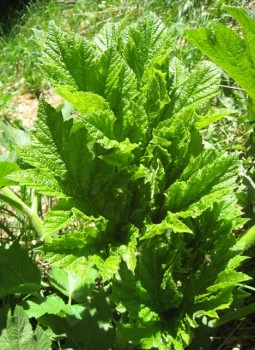
- Set a pot of silty tap water to boil.
- Clean sink and fill with enough siltwater to cover roadside cow parsnip.
- Wash plant parts thoroughly to remove dust and road chemicals (very, very well, in other words).
- Boil in silty tap water for 10 minutes and strain.
- Cover with more siltwater and bring to a boil, then remove from heat and strain.
It may sound nasty because that’s kind of how I felt about it—until I tasted it, that is. That roadside cow parsnip turned out to be quite the delicacy. After straining it, I removed the soggy goodness with tongs on account of its extreme tenderness. Then I sprinkled a generous portion of chopped Vidalia onions and smaller amounts of soy sauce and butter (Smart Balance imitation butter, actually) on top and worked the ingredients gently into the mushy mass.
Ah. I very much echo the Marchs’ sentiment about the wonderful, wild, and woolly flavor of new cow parsnip leaves. It was absolutely amazing and I savored every minute of it.
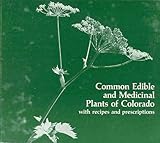 The Marchs’ book is now out of print and expensive despite the fact that it is but a humble two-color piece with so delicate a binding that the pages fall out all the time. Still, I think those two were onto something. The cow parsnip is delicious, enhanced all the more by their flavorful, exotic descriptions.
The Marchs’ book is now out of print and expensive despite the fact that it is but a humble two-color piece with so delicate a binding that the pages fall out all the time. Still, I think those two were onto something. The cow parsnip is delicious, enhanced all the more by their flavorful, exotic descriptions.
The End
[By the way, if anyone reading this out there is local, you can check the book out from the Fairplay, Colorado public library.]
WARNING: Contact with cow parsnip in the sunlight while sweating can cause a bad skin reaction. I have never experienced this but if doing so under such conditions, gloves might be merited. Thayer (2010) describes a related plant, giant hogweed (H. mantegazzianum), which has become invasive in areas of Ontario, the eastern US, the Pacific Northwest, and elsewhere, that is “extremely dangerous” in terms of its potential to burn the skin and eyes. He thinks it “might” be edible, but readers should regardless exercise caution with H. mantegazzianum, which he describes as having “more deeply cut leaf lobes” and says “can grow to 16 feet in height.”

where does one get silty water? or did you mean salty???
Hi Jess, Actually the “silty” bit was a joke because our tap water was a mess. It is preferable NOT to use silty water. That’s just all I had.
Very interesting! I’ve been eating the pealed young leaf and flower stalks for years but never tried the young leaves themselves. I’ll give them a shot this spring.